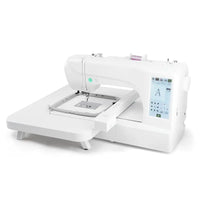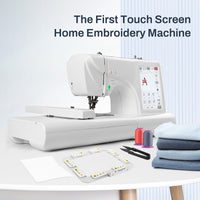Table of Contents
- Introduction: Why Convert PES Embroidery Files?
- Method 1: Converting Directly within Palette 11
- Method 2: Batch Conversion with Palette 11 Design Database
- Method 3: Using the Free Embroidery Tool Shed by DIME
- Method 4: The Free Floriani Software Converter
- Comparing Your Options: Which Method is Best for You?
Introduction: Why Convert PES Embroidery Files?
Converting files broadens what your embroidery machine can stitch. Whether you use a Brother, Baby Lock, Husqvarna, or another model, chances are your designs arrive in differing formats. Having a reliable converter keeps creativity flowing. Many crafters use magnetic embroidery hoops for brother so they can smoothly test different hoop sizes once their files are in the right format, minimizing rehooping effort.
Understanding embroidery file formats
Every embroidery brand writes stitch data a bit differently. The PES format—used by Brother and Baby Lock—is among the most common, but not universal. Others rely on DST, JEF, EXP, or HUS. Tools like Palette 11 or Floriani translate these instructions, though precision sometimes varies by format and hoop size.
Common reasons for conversion
Perhaps you upgraded to a new machine, share designs with friends, or sell digital patterns on multiple platforms. Converting properly ensures readability and preserves design integrity. Using format converters is as essential as choosing sturdy babylock hoops for consistent stitching alignment.
Method 1: Converting Directly within Palette 11
Palette 11 is Baby Lock’s proprietary software and a logical first stop. Regina opens it, loads a PES file, and demonstrates the built-in export tool.

Step-by-step export process
Choose File → Export File, then select the desired format under Save as type. Supported options—like DST or EXP—appear in the dropdown.

Click Save, check your new file in the output folder, and verify that your machine reads it. Even small design elements remain intact when exported correctly.

Understanding the format limitations
Palette 11 only supports limited outputs, and trying unsupported formats (like JEF for very large motifs) can trigger an error message.

Troubleshooting common errors
If you see such alerts, save under another format or move to Palette 11’s Design Database for more flexibility. Keeping a backup of your original file before conversion protects your embroidery investment.
Method 2: Batch Conversion with Palette 11 Design Database
The video next shifts to the Design Database tool — a companion utility inside Palette 11 built for efficiency.

Accessing the Design Database
Find it via the Windows Start menu under your Palette 11 folder or use a desktop shortcut.

Converting a single file
Once open, navigate to your folder, right-click a file, and choose Convert Format. You’ll then designate the destination folder and file type.

How to convert multiple files at once
Holding Ctrl lets you highlight several designs, right-click, and convert them simultaneously. Regina notes this as the fastest route for bulk jobs.

Anyone testing grouped hoop compatibility, such as with snap hoop monster for babylock, will appreciate how batch conversion keeps design sets consistent across file types.
Method 3: Using the Free Embroidery Tool Shed by DIME
Regina’s third method introduces a no-cost option from Designs in Machine Embroidery (DIME). You can get the Embroidery Tool Shed directly from their website.

Where to find and download the software
Once installed, it’s easily accessed from your taskbar. Because the software loads multiple files at once, it’s ideal for reviewing design groups.

Opening and saving files in new formats
Navigate to File → Open, select your designs, then use File → Save As to pick formats such as SHV or EXP.

This broader list makes the Tool Shed a strong backup when Palette 11 rejects certain outputs.
Advantages over Palette 11
Embroidery Tool Shed doesn’t limit import size as strictly, though each file must still be saved individually. It’s especially convenient for creators toggling between different hoop systems, like magnetic embroidery hoops for babylock or even crossover frames such as the dime magnetic hoop for brother.
From the comments: While no viewer questions were logged on this upload, community sentiment on DIME forums often praises its versatility and frequent updates.
Method 4: The Free Floriani Software Converter
A second free pathway shown in the video is Floriani’s conversion utility.

An overview of Floriani’s tool
Floriani’s interface resembles Embroidery Tool Shed, allowing multiple open tabs for simultaneous editing and export.

Converting files step-by-step
Open each design in a tab, go to File → Save As, pick the destination folder, choose a file type like JEF, and save. Repeat for remaining tabs.

Since each must be saved individually, this method suits smaller project batches.
Comparing Your Options: Which Method Is Best for You?
In short:
- Palette 11 (Direct) – Quick for single files.
- Design Database – Perfect for bulk conversions.
- Embroidery Tool Shed (Free) – Greatest format diversity.
- Floriani (Free) – User-friendly and cross-compatible.

If speed and automation are priorities, the Design Database wins. For versatility, the DIME and Floriani options deliver. For built-in reliability under the Baby Lock ecosystem, Palette 11 remains solid.
Ultimately, the right choice aligns with your workflow—whether you manage hundreds of designs daily or prepare custom sets for machines using magnetic hoops for embroidery machines.
From the comments: No user questions were logged at the time of publication, but Regina invites viewers to share experiences in the video’s thread. Common tips across embroidery forums include maintaining organized folders and documenting which software produced each design version for faster troubleshooting.
Quick recap:
- Try Palette 11 first for native exports.
- Move to Design Database for multi-file speed.
- Explore free tools for expanded format options.
Following these methods, you can streamline your workflow and confidently prepare designs for nearly any embroidery machine.



